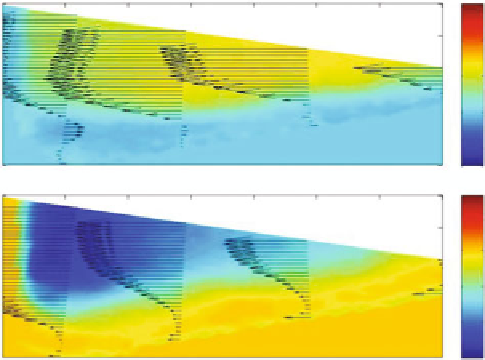Geoscience Reference
In-Depth Information
1
30
0.8
20
0.6
0.4
10
0
0.2
0
0
10
−
0.2
0.4
0.6
0.8
1
1.2
1.4
1
10
0.8
0
0.6
0.4
−
10
−
20
0.2
0
−
30
0
0.2
0.4
0.6
0.8
1
1.2
1.4
x/D
(
−
)
Fig. 41 Time-averaged velocity components in test CC, in the scour hole, at 45
from the symmetry
axis. On
top
:longitudinalcomponent
u
p
;
bottom
: vertical component
w
. Velocities in cm/s
cylinder, the situation reverses: the longitudinal component of the velocity
decreases, accompanied with successively increasing values of the vertical compo-
nent. Flow separation is observed near the flow bed: the velocity profiles obtained at
0.4
1.0 show negative values of the
u
-component and positive values of
the vertical component, in opposition of the flow pattern in the upper layers, which
indicates the existence of rotational flow in this region. Inside the scour hole, the
flow pattern is similar to the previously observed, being quite clear the dominance
of the downward-flow against the longitudinal, near the face of the cylinder.
In Fig.
42
, the time-averaged vorticity maps for each measuring plane are
presented. In the symmetry axis and in the plane at 30
, there seems to occur
flow separation in the beginning of the scour hole, which generates a vortex of
different characteristics of the horseshoe vortex observed in fixed bed. Both vor-
texes have the same sign of vorticity, which implies the existence of small vortical
structures in counter-rotation between them for the sake of continuity.
Inside the scour hole, near the bed, the existence of two regions of maximum
vorticity is noticed. The instantaneous maps show the intermittent behavior of the
horseshoe vortex (Fig. 43). Near the cylinder face, negative values are observed of
vorticity and of higher intensity than what was detected near the bed. This leads to
the conclusion that, inside the scour hole, the vorticity generated in the boundary
layer which develops along the wall of the cylinder, due the presence of the
downflow, is more permanent and relevant than the vorticity generated near the
bed (Fig.
43
).
As a summary, it can be said that the downflow upstream the cylinder plays a
major role in the mechanism of local scour near the obstacle. The down-flow acts as
x
/
D

